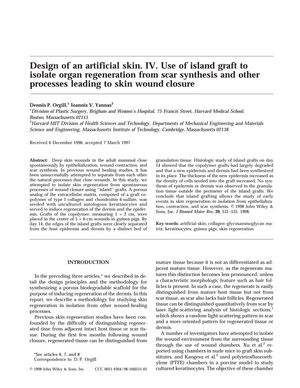Design of an Artificial Skin. IV. Use of Island Graft to Isolate Organ Regeneration from Scar Synthesis and Other Processes Leading to Skin Wound Closure
March 1998
in “
Journal of Biomedical Materials Research
”

TLDR Island grafts can help study skin regeneration separately from other healing processes.
In the 1998 study by Orgill and Yannas, the use of "island" grafts was explored as a means to separate skin regeneration from other wound healing processes. The researchers applied grafts made from a copolymer of type I collagen and chondroitin 6-sulfate, which were seeded with autologous keratinocytes, to 5 × 6-cm wounds on guinea pigs. These grafts, sized 1 × 2 cm, were placed in the wound centers and by day 14, they were surrounded by granulation tissue, indicating separation from the host skin. Histological analysis revealed that the copolymer had mostly degraded and was replaced by newly synthesized epidermis and dermis. The thickness of the new epidermis correlated with the density of the seeded cells. Importantly, no synthesis of epidermis or dermis was noted outside the graft area. The study successfully demonstrated that island grafting is a viable method to study skin regeneration independently from other healing processes such as epithelialization, contraction, and scar formation.